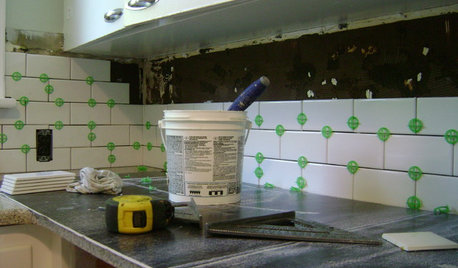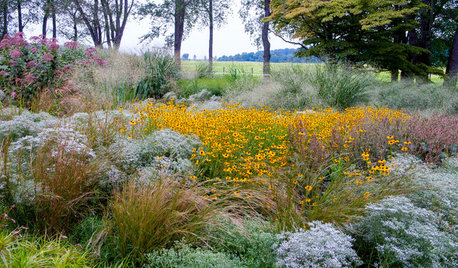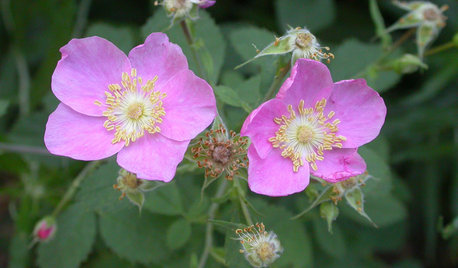How to save roses with rust on every leaf?
pasack
12 years ago
Featured Answer
Comments (31)
pasack
12 years agoRelated Discussions
Can you really spray every leaf?
Comments (6)The secret is to have lots of pressure behind the spray. The more pressure, the finer the mist resulting in the best coverage. Powered sprayers tend to have greater pressure, thus a finer mist. Mine has a four foot wand with a nozzle that breaks the droplets into very fine particles. I poke the wand facing up under the bottom of a bush, The force of the spray forms a mist that coats all the under portions of the leaves and allows the overspray to settle on much of the leaf top surface. A quick overspray of the canopy covers the rest of the upper surface. Mine was built by Ken Muncy. Another one is the electric Atomist sprayer. It does a great job in very little time. The blower creates a fine mist powered by a stream of air that blows away any loose leaves and covers all the leaves with a quick pass. The spray will do a tall climber or get hard to reach bushes. The drawback is the electric cord and small tank. On the plus side, you get done in half the time using half as much product. They can cost over $200, but I've seen then a little cheaper by searching on google for the atomist 1026B The one gallon pump up sprayers have to be pumped often to maintain enough pressure. As the pressure decreases the droplets get larger, covering less area and using more product. The one for garden applications is on the left....See MoreCure daylily leaf streak? not rust, I think....
Comments (15)Wow. Thanks, y'all. I'll address the comments *about maybe it being dormancy and life cycle: could be... but the lilies I see in the ditches don't look aweful like mine. (My neighbor's look great, too... but they're Stella d'Oro.) I have cut them down around August, and they grow right back up, & go through the whole streaking cycle again (but no flowers). *about the plans being extreme. Well... I'm dividing and transplanting them anyway (I need them elsewhere: where they will get merciless sun all day, and be thinned out)... So really the only extra step is the dipping/soaking, whatever. And hopefully that'll save me any work later in the summer. So, if I'm covering all bases... will it HARM the plants to go into a bleach bath, regardless of whether it's dormancy or fungal infection? If not... then what's the concentration? And how about the fungicide? What's with the cornmeal? Thanks, y'all, for helping! Charla...See MoreHow to save a potted gift rose
Comments (155)Hello! I just got my rose bush from one of those ship to your door flower delivery companies for my Birthday. I have read a lot of the comments and see that there is little chance these guys surviving, I still want to try as it was a gift! The pot it came in was pretty small and all the buds were dying and some of the leaves too, so I decided to repot it. With some advise from the internet I repotted it the best I could. Now i feel like it’s dying in earnest. I think I’ve been over watering it so I will hold off until it dries now, but I’m wondering if there is anything else I can do? I have a northerly facing apartment that gets sun for only a couple of hours in the morning. I took it out today and basically set it in the stairwell where the sun was setting to get more sun for the day. The leaves are mostly wilting and dying with a few spare yellow leaves here and there. Also there are some of the stems that have turned brown and seem very hard. Should I be trimming those back? I trimmed all of the dead leaves but I’m not sure if the stems are supposed to be turning brown like this? Pictures are below! Thanks for all of your help!...See MorePlease give me two to three disease, rust resistant rose bushes!!
Comments (32)I know! Which is why I bought 3 bushes. One of them, in my perennial bed gets bs late in the season but the other two get bs to the point that I am considering removing them. I don't have any trouble with my Kiss Me or Sunrise Sunset, Kashmir, Como Park or my Weeks rose Drop Dead Red. If you want a good hybrid tea style red rose Drop Dead red and Kashmir have been good in my bs magnet garden in humid hot SW Ohio at the height of summer. i have had good luck so far with all my Kordes roses and with Belinda's Dream ( touch wood)....See Morejacqueline9CA
12 years agozack_lau z6 CT ARS Consulting Rosarian
12 years agojerijen
12 years agoroseseek
12 years agojerijen
12 years agoroseseek
12 years agorideauroselad OkanaganBC6a
12 years agojerijen
12 years agoroseseek
12 years agomichaelg
12 years agoelks
12 years agojerijen
12 years agolandperson
12 years agoroseseek
12 years agolandperson
12 years agoblazeaglory
12 years agojerijen
12 years agoKippy
12 years agojeffcat
12 years agoblazeaglory
12 years agoUser
12 years agohenry_kuska
12 years agojerijen
12 years agohenry_kuska
12 years agojacqueline9CA
12 years agoingrid_vc so. CA zone 9
12 years agozack_lau z6 CT ARS Consulting Rosarian
12 years agopeachymomo
12 years agoharmonyp
12 years ago
Related Stories

MOST POPULAR19 Kitchen Projects Every Homeowner Should Know About
Could your kitchen use a new sink, a backsplash, updated hardware, better organization, a good cleaning? Here's how to get started
Full Story
GARDENING GUIDESThe Surprising Ingredients Every Good Garden Should Have
See what to do — and not do — for lasting rewards in your landscape
Full Story
LIFEYou Said It: ‘Every Centimeter Counts’ and Other Houzz Quotables
Highlights from the week include Sesame Street pumpkins, embracing the old-fashioned kitchen table and a clever DIY project
Full Story
LANDSCAPE DESIGNGet Along With Less Lawn — Ideas to Save Water and Effort
Ditch the mower and lower your water bill while creating a feast for the eyes with diverse plantings and gathering places
Full Story
WINTER GARDENINGPruning Secrets for Exquisite Roses
Encourage gorgeous blooms year after year with this time-tested advice on how to prune your rosebush in winter for health and shape
Full Story
GARDENING GUIDES6 Wonderfully Easy Roses for Any Gardener
Look like an expert even if you're just starting out, with these low-maintenance gems of the rose world
Full Story
GARDENING GUIDES6 Captivating Roses for an Alluringly Fragrant Garden
Perfume your garden with aromas from richly spicy to lightly sweet, without sacrificing an inch of color
Full Story
PATIOSPatio Details: A Custom Aluminum Arbor Cools Things Down in Texas
Panels in the roof have leaf pattern cutouts that create dappled shade and a calm, relaxed ambience
Full Story
GARDENING GUIDESGreat Design Plant: Rosa Californica
Plant California wild rose for easy care and a touch of romance in your native garden
Full Story
GREEN BUILDINGHow to Harvest Rainwater for Your Garden
Conserve a vital resource and save money by collecting stormwater for irrigation in a barrel or tank
Full Story




roseseek